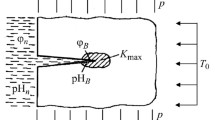We formulate a computation model (differential equation with initial and final conditions) for the determination of the period of subcritical growth of small plane high-temperature creep cracks in structural elements. The model is based on the first law of thermodynamics, determination of the energy components of deformation of the process zone near the crack contour via the parameters of its opening, and approximate reduction of the process of creep of the material to a period of steady-state creep. The formulas for the approximate evaluation of the opening displacements of the process zone via the stress intensity factor and the mean values of loading of the structural elements are proposed. The method of equivalent areas generalized for the deformation parameters is used for the approximate solution of the problem. By using this method and the experimental data known from the literature for specific materials, we determine the period of subcritical growth of a small surface semielliptic high-temperature creep crack under the conditions of long-term static tension in a half space.




Similar content being viewed by others
References
S. Taira, R. Ohtani, and T. Kitamura, “Application of J-integral to high-temperature crack propagation: Part I. Creep crack growth,” J. Eng. Mater. Technol., 101, 154–161 (1979).
O. E. Andreikiv and N. B. Sas, “Fracture mechanics of metallic plates under the conditions of high-temperature creep,” Fiz.-Khim. Mekh. Mater., 42, No. 2, 62−68 (2006); English translation: Mater. Sci., 42, No. 2, 210−219 (2006).
O. E. Andreikiv and N. B. Sas, “Subcritical growth of a plane crack in a three-dimensional body under the conditions of high-temperature creep,” Fiz.-Khim. Mekh. Mater., 44, No. 2, 19–26 (2008); English translation: Mater. Sci., 44, No. 2, 163–174 (2008).
O. E. Andreikiv and N. B. Sas, “Strength of thin-walled structural elements with cracks under the conditions of creep,” Fiz.-Khim. Mekh. Mater., 43, No. 2, 33–39 (2007); English translation: Mater. Sci., 43, No. 2, 174−182 (2007).
R. O. Ritchie and S. Suresh, “Mechanics and physics of the growth of small cracks,” in: Behavior of Short Cracks in Airframe Components, AGARD Conference Proceedings, No. 328, NATO Advisory Group for Aerospace Research and Development, Neuilly-sur-Seine, France (1983), pp. l-l–1-14.
O. E. Andreikiv, N. S. Shtayura, and R. Ya. Yarema, “Energy-based approach to evaluation of short fatigue crack growth rate in plates,” Strength Mater., 49, No. 6, 778–787 (2017).
О. E. Andreikiv, A. R. Lysyk, N. S. Shtayura, and A. V. Babii, “Evaluation of the residual service life of thin-walled structural elements with short corrosion-fatigue cracks,” Fiz.-Khim. Mekh. Mater., 53, No. 4, 84–90 (2017); English translation: Mater. Sci., 53, No. 4, 514–521 (2018).
O. E Andreikiv., I. Ya. Dolins’ka, and N. V. Yavors’ka, “Estimation of the periods of initiation and propagation of creep-fatigue cracks in thin-walled structural elements,” Fiz.-Khim. Mekh. Mater., 47, No. 3, 7–15 (2011); English translation: Mater. Sci., 47, No. 3, 273–283 (2011).
O. E. Andreikiv, R. M. Lesiv, and I. Ya. Dolins’ka, “Dependence of the period of subcritical growth of a creep fatigue crack on the duration of loading cycles,” Fiz.-Khim. Mekh. Mater., 45, No. 4, 31–38 (2009); English translation: Mater. Sci., 45, No. 4, 494–503 (2009).
M. Shata and Z. O. Terlets’ka, Energy Approach in Mechanics of Fatigue Propagation of a Macrocrack. Fracture Mechanics and Strength of Structures [in Ukrainian], Issue 2, Kamenyar, Lviv (1999), pp. 141–148.
R. М. MсMeeking, “Finite deformation analysis of crack tip opening in elastic-plastic materials and implications for fracture,” J. Mech. Phys. Solids, 25, No. 5, 357–381 (1977).
M. P. Savruk, Stress Intensity Factors in Bodies with Cracks [in Russian], Naukova Dumka, Kiev (1988).
A. Fuji and М. Kitagawa, “A comparison of creep crack growth behaviour in nickel based super alloy with low alloy steel,” in: Advances in Fracture Resistance and Structural Integrity: Selected Papers from the 8th Internat. Conf. on Fracture (ICF 8) (Kyiv, June 8–14, 1993), Pergamon Press (1994), pp. 487–495.
N. Yadzhak, “Generalization of the equivalent area method for the case of short fatigue cracks in a three-dimensional body,” Visn. Lviv Univ. Ser. Mech. Math., No. 89, 134–141 (2020).
Author information
Authors and Affiliations
Corresponding author
Additional information
Translated from Fizyko-Khimichna Mekhanika Materialiv, Vol. 57, No. 2, pp. 16–23, March–April, 2021.
Rights and permissions
About this article
Cite this article
Andreikiv, О.Y., Dolinska, І.Y. Determination of the Period of Subcritical Growth of Small Plane High-Temperature Creep Cracks in Structural Elements. Mater Sci 57, 154–162 (2021). https://doi.org/10.1007/s11003-021-00526-1
Received:
Published:
Issue Date:
DOI: https://doi.org/10.1007/s11003-021-00526-1




